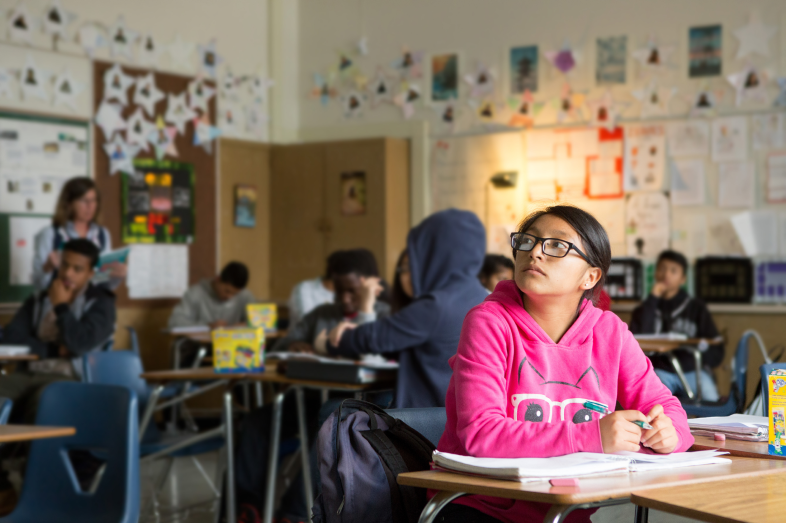Raymond Pierce said he was in high school on his way to college when the U.S. Supreme Court in 1974 ruled that federal courts didn’t have to interfere in local school desegregation efforts in Milliken v. Bradley.
Plaintiffs in the case out of Detroit, Michigan, argued that suburban districts around Detroit were becoming increasingly white and segregated while Detroit’s district was predominantly Black. Suburban district borders increasingly and intentionally kept Black students out, they argued, through racist housing policies.
Pierce, now president and CEO of the Southern Education Foundation, said he saw the ruling at the time as “another symbol of a return to apartheid.” And today, he said, many school districts are still under federal desegregation orders, just one signal of many that the devastating impacts of segregation on students of color remain in 2023.
“It has to be a combined, comprehensive, strategic movement to address what we know are inequities in public education under a very daunting political environment,” he said during a panel at the 2023 Education Writers Association National Seminar on June 3.
Moderated by Mike Hixenbaugh of NBC News Digital, the panel included Andrew Brennen with the Kentucky Student Voice Team, Celina Moreno with IDRA and Juontel White with the Schott Foundation for Public Education.
The speakers addressed how landmark rulings like Milliken have shaped education, what equity looks like in the classroom today, and where education systems fall short in serving historically marginalized groups of students, including students of color, LGBTQ students and students with disabilities.
Putting Student Voices Front and Center
The panelists discussed some of the civil rights issues facing students this year.
Brennen said he was a The University of North Carolina at Chapel Hill student when he first heard about Students for Fair Admissions v. The University of North Carolina, an ongoing case awaiting a Supreme Court decision, in which plaintiffs claim that race-conscious admissions discriminate against white and Asian American applicants.
That case, Brennen said, didn’t sit right with some Black students on UNC’s campus. The role and purpose of college is often lost in debates around affirmative action, he said. And through a broader lens, journalists should examine how diversity in these institutions can benefit society and democracy.
“The fact of the matter is that if our colleges are meant to be incubators for our democracy, and if we want a democracy that’s multicultural, pluralistic, diverse, then those are the conditions that we have to be cultivating on our college and university campuses,” Brennen said.
He stressed the importance of leading with student voices in journalism, particularly when writing about higher education spheres.
Moreno, too, wants classrooms where students “don’t have to leave their identities, their languages and their cultures behind.”
She raised the issue of school-funding cases – in the context of San Antonio Independent School District v. Rodriguez, a case beginning in 1968: Parents argued schools in property-poor areas lacked funding for quality education compared with schools in wealthy areas, which could – and still can in many cases – raise funds through property taxes.
The court ruled in 1973 that there weren’t constitutional violations in this funding system, and because of that, funding inequities continue to persist in states with inequitable school funding systems, Moreno said.
In rulings like the 1982 Plyler v. Doe, she said, courts have set hopeful precedent: The Supreme Court ruled that immigration status should not lead to a child being denied an education.
Yet more recently, Texas Gov. Greg Abbott said the country should revisit Plyler v. Doe, a “dangerous precedent” to Moreno.
“We have to support students and communities in spaces and policy because we can’t rely on the federal court system in the same way as before,” she said.
Looking Critically at Policies and Frameworks in Education
White encouraged journalists to dig deeper and build information bridges from current events to the historical context underlying those issues.
She referenced a report she co-authored at Columbia University, tracing inequities in the United States since Brown v. Board of Education. One area that the report examines is curricula and how academic frameworks frequently center white, European narratives in ways that minimize and erase communities of color.
Today, battles at the school and district-levels over curricula should be examined through that lens, she said.
“We’re in a conversation of political and state-level battles around what is being taught in education,” she said. “We have never yet fully addressed how we become more racially inclusive in what we are teaching our students.”
Education Civil Rights Cases to Know
Pierce, Moreno, Brennen, White and Hixenbaugh cited multiple civil rights cases that have influenced policy in education today.
Here are some important ones reporters should know:
- Brown v. Board of Education: The U.S. Supreme Court ruled in 1954 that segregation of public schools was a violation of the 14th Amendment. This decision reversed precedent set by the court decades earlier in Plessy v. Ferguson, in which justices had ruled that “separate but equal” segregation did not violate the constitution.
- San Antonio Independent School District v. Rodriguez: In 1968, a group of parents sued Texas amid protests over inequitable resources for low-income, predominantly Latino schools. While a federal district court ruled that Texas’ system for funding schools was unconstitutional, the U.S. Supreme Court found no constitutional violations in the system, which largely favored wealthy schools.
- Milliken v. Bradley: Milliken, in 1974, questioned who bore the responsibility for desegregating schools, two decades after the Brown decision. The case revolved around a plan to desegregate Detroit’s schools, which would have included white, suburban schools. Families in the predominantly white districts argued the courts couldn’t impose such a plan because it conflicted with local control. The Supreme Court sided with the suburban districts, limiting Detroit’s efforts to desegregate its public schools for decades to come.
- Plyler v. Doe: In 1982, the Supreme Court held that a Texas law barring students who weren’t U.S. citizens from public school violated the Equal Protection Clause of the 14th Amendment. Reporters should note when school enrollment policies require government-issued I.D.
Story Ideas: Covering Civil Rights Today
- Curriculum: How does curricula in school districts include or erase the narratives of people of color? LGBTQ populations? Who makes the decision to set curricula in your state, and what belies school board-level debates about diversity and equity programming in schools?
- Mental health accessibility for LGBTQ students in higher education: Do higher education institutions have enough mental health resources for LGBTQ students, particularly in states that have become political battlegrounds for LGBTQ rights?
- What it takes to be a student activist: It takes time and financial investment to be a student activist, Brennen said. What sacrifices do student activists make so their voices are heard? And what barriers exist that keep students from becoming more active in civic issues and policy?


